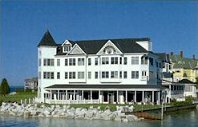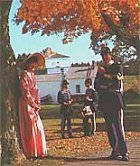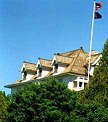During the later half of the 19th-century, large excursions boats would sail to Mackinac Island, during the summer months, from Buffalo, Cleveland, Chicago and Detroit. Railroad and boat companies began erecting hotels to accommodate  these overnight guests, but quarters were need for wealthy entrepreneurs that would stay for more than just a few nights. Families such as the Cudahys and Armours (of Chicago meat packaging fame) opted to build summer homes on the Western Bluffs of Mackinac. These summer "cottages" were typically Victorian in style with turrets, gables, verandas, wraparound porches, a dozen bedrooms and, until modern times, one bath. Many of these homes have since these overnight guests, but quarters were need for wealthy entrepreneurs that would stay for more than just a few nights. Families such as the Cudahys and Armours (of Chicago meat packaging fame) opted to build summer homes on the Western Bluffs of Mackinac. These summer "cottages" were typically Victorian in style with turrets, gables, verandas, wraparound porches, a dozen bedrooms and, until modern times, one bath. Many of these homes have since  been converted into bed and breakfast inns. The Iroquois Inn was originally a private residence, but has since been converted into a guest house, complete with a dining room, the Carriage House, offering some of the best culinary talents on the Island. Another guest house on the island that is living a second life is Haan's 1830 Inn. This Greek Revival residence was once the private home of Colonel Preston, one of the last officers at Fort Mackinac and also, the first mayor of the island at the turn of the century. been converted into bed and breakfast inns. The Iroquois Inn was originally a private residence, but has since been converted into a guest house, complete with a dining room, the Carriage House, offering some of the best culinary talents on the Island. Another guest house on the island that is living a second life is Haan's 1830 Inn. This Greek Revival residence was once the private home of Colonel Preston, one of the last officers at Fort Mackinac and also, the first mayor of the island at the turn of the century.
Fort Mackinac was built by British troops in 1780. The high bluff
location was  selected because of the view it offered of the Straits below. Following the French-Indian War, the fort was turned over to the Americans, who used it as a military post to control ship traffic in the Straits. The British discovered in 1812, that the location of the fort was not the selected because of the view it offered of the Straits below. Following the French-Indian War, the fort was turned over to the Americans, who used it as a military post to control ship traffic in the Straits. The British discovered in 1812, that the location of the fort was not the  highest point on the island. After hiking inland from the north shore, they found the highest spot and built Fort Holmes on it. Their superior position allowed them to overtake Fort Mackinac without firing a single shot. Today, the fort is open to the public, offering interactive learning experiences. Fourteen of the original buildings have been restored and are available for touring. Costumed guides stroll the property explaining how the families of officers lived during 1880's. Demonstrations are held throughout the day to instruct on the methods of loading cannons and firearms for battle. highest point on the island. After hiking inland from the north shore, they found the highest spot and built Fort Holmes on it. Their superior position allowed them to overtake Fort Mackinac without firing a single shot. Today, the fort is open to the public, offering interactive learning experiences. Fourteen of the original buildings have been restored and are available for touring. Costumed guides stroll the property explaining how the families of officers lived during 1880's. Demonstrations are held throughout the day to instruct on the methods of loading cannons and firearms for battle.
Other area attractions:
In 1901 Patrick Doud built a victorian cottage just west of Fort Mackinac
for  Lawrence Young. The State of Michigan purchased the property in 1945 for $15,000, and planned to use the houses as the Governor's Summer Residence. This house has hosted national political figures as well as local, including John F. Kennedy who visited with Michigan Governor G. Mennen Williams in 1960, and won the Democratic support of the state. More recently Bill Clinton, Newt Gingrich and Bob Dole visited to conferred with state officials. Lawrence Young. The State of Michigan purchased the property in 1945 for $15,000, and planned to use the houses as the Governor's Summer Residence. This house has hosted national political figures as well as local, including John F. Kennedy who visited with Michigan Governor G. Mennen Williams in 1960, and won the Democratic support of the state. More recently Bill Clinton, Newt Gingrich and Bob Dole visited to conferred with state officials.
A statue of Father Jacques Marquette is a popular attraction on Mackinac  Island. Father Marquette came to the island in 1671, and preached to the Indians. It was shortly after this that the fur trade with the Indians began at Mackinac, making it the most important French western fur trade site. He established the first permanent mission for local Chippewa tribes at St Ignace, on the north side of the Straits. In 1675, he was joined by Louis Joliet, a French explorer of what is now the Midwestern United States. Together they would achieve lasting fame as the discovers of the upper Mississippi River. Island. Father Marquette came to the island in 1671, and preached to the Indians. It was shortly after this that the fur trade with the Indians began at Mackinac, making it the most important French western fur trade site. He established the first permanent mission for local Chippewa tribes at St Ignace, on the north side of the Straits. In 1675, he was joined by Louis Joliet, a French explorer of what is now the Midwestern United States. Together they would achieve lasting fame as the discovers of the upper Mississippi River. |
|
The Carriage House
Roasted Chicken with Calamata Olives and Potatoes
|
1 qt Chicken Stock |
|
2 t fresh thyme, chopped |
|
4 Skin-on Boneless Chicken Breast Halves |
1 c Calamata Olive Paste (see recipe below) |
4 Small Red Potatoes |
1/2 c Calamata Olives for garnish |
3 oz. Olive Oil |
|
In a sauce pan, combine the chicken stock and thyme. Over moderately high heat, simmer until the stock reduces to a fairly thick, sauce like consistency. This will take about 1 hour and can be prepared ahead of time. The reduced thyme sauce should coat the back of a spoon when finished. Set aside.
While sauce reduces, prepare the olive paste (see recipe below). Then spread the paste evenly on the underside of the chicken breasts.
Cut the potatoes into quarters.
In a saute pan, heat olive oil until nearly smoking. Carefully place breasts in pan, skin side down, and allow the skin to sear. Add potatoes to the saute pan and place in a preheated oven at 375 degrees for 8 to 12 minutes or until chicken centers are no longer pink. Stir potatoes after the first 6 minutes of cooking time to brown evenly, and add the olives to the pan when you stir the potatoes.
Transfer cooked chicken to a cutting board, skin side down, and slice each chicken breast half into three even pieces.
Arrange the chicken pieces, skin side up, on 4 dinner plates and place olives and potatoes around the chicken.
Gently bring the thyme sauce back to a simmer, spoon sauce evenly over chicken and serve. Serves 4.
CALAMATA OLIVE PASTE
|
1 c Calamata Olives, pits removed |
|
1 T Fresh Chopped Basil Leaves |
|
5 Cloves Garlic |
2 oz. Olive Oil |
In a food processor or blender, mix all ingredients until it forms a smooth
paste. Yields 1 cup. |

 these overnight guests, but quarters were need for wealthy entrepreneurs that would stay for more than just a few nights. Families such as the Cudahys and Armours (of Chicago meat packaging fame) opted to build summer homes on the Western Bluffs of Mackinac. These summer "cottages" were typically Victorian in style with turrets, gables, verandas, wraparound porches, a dozen bedrooms and, until modern times, one bath. Many of these homes have since
these overnight guests, but quarters were need for wealthy entrepreneurs that would stay for more than just a few nights. Families such as the Cudahys and Armours (of Chicago meat packaging fame) opted to build summer homes on the Western Bluffs of Mackinac. These summer "cottages" were typically Victorian in style with turrets, gables, verandas, wraparound porches, a dozen bedrooms and, until modern times, one bath. Many of these homes have since  been converted into bed and breakfast inns. The Iroquois Inn was originally a private residence, but has since been converted into a guest house, complete with a dining room, the Carriage House, offering some of the best culinary talents on the Island. Another guest house on the island that is living a second life is Haan's 1830 Inn. This Greek Revival residence was once the private home of Colonel Preston, one of the last officers at Fort Mackinac and also, the first mayor of the island at the turn of the century.
been converted into bed and breakfast inns. The Iroquois Inn was originally a private residence, but has since been converted into a guest house, complete with a dining room, the Carriage House, offering some of the best culinary talents on the Island. Another guest house on the island that is living a second life is Haan's 1830 Inn. This Greek Revival residence was once the private home of Colonel Preston, one of the last officers at Fort Mackinac and also, the first mayor of the island at the turn of the century.
 selected because of the view it offered of the Straits below. Following the French-Indian War, the fort was turned over to the Americans, who used it as a military post to control ship traffic in the Straits. The British discovered in 1812, that the location of the fort was not the
selected because of the view it offered of the Straits below. Following the French-Indian War, the fort was turned over to the Americans, who used it as a military post to control ship traffic in the Straits. The British discovered in 1812, that the location of the fort was not the  highest point on the island. After hiking inland from the north shore, they found the highest spot and built Fort Holmes on it. Their superior position allowed them to overtake Fort Mackinac without firing a single shot. Today, the fort is open to the public, offering interactive learning experiences. Fourteen of the original buildings have been restored and are available for touring. Costumed guides stroll the property explaining how the families of officers lived during 1880's. Demonstrations are held throughout the day to instruct on the methods of loading cannons and firearms for battle.
highest point on the island. After hiking inland from the north shore, they found the highest spot and built Fort Holmes on it. Their superior position allowed them to overtake Fort Mackinac without firing a single shot. Today, the fort is open to the public, offering interactive learning experiences. Fourteen of the original buildings have been restored and are available for touring. Costumed guides stroll the property explaining how the families of officers lived during 1880's. Demonstrations are held throughout the day to instruct on the methods of loading cannons and firearms for battle.
 Lawrence Young. The State of Michigan purchased the property in 1945 for $15,000, and planned to use the houses as the Governor's Summer Residence. This house has hosted national political figures as well as local, including John F. Kennedy who visited with Michigan Governor G. Mennen Williams in 1960, and won the Democratic support of the state. More recently Bill Clinton, Newt Gingrich and Bob Dole visited to conferred with state officials.
Lawrence Young. The State of Michigan purchased the property in 1945 for $15,000, and planned to use the houses as the Governor's Summer Residence. This house has hosted national political figures as well as local, including John F. Kennedy who visited with Michigan Governor G. Mennen Williams in 1960, and won the Democratic support of the state. More recently Bill Clinton, Newt Gingrich and Bob Dole visited to conferred with state officials.
 Island. Father Marquette came to the island in 1671, and preached to the Indians. It was shortly after this that the fur trade with the Indians began at Mackinac, making it the most important French western fur trade site. He established the first permanent mission for local Chippewa tribes at St Ignace, on the north side of the Straits. In 1675, he was joined by Louis Joliet, a French explorer of what is now the Midwestern United States. Together they would achieve lasting fame as the discovers of the upper Mississippi River.
Island. Father Marquette came to the island in 1671, and preached to the Indians. It was shortly after this that the fur trade with the Indians began at Mackinac, making it the most important French western fur trade site. He established the first permanent mission for local Chippewa tribes at St Ignace, on the north side of the Straits. In 1675, he was joined by Louis Joliet, a French explorer of what is now the Midwestern United States. Together they would achieve lasting fame as the discovers of the upper Mississippi River.















